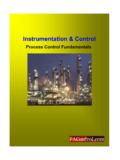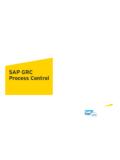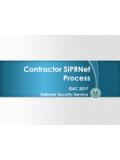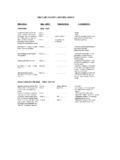Transcription of Process Mapping - Simple Improvement Training, …
1 Process MappingA Simple approach to Improvement by making a Process visibleAn article by Dr. Mike Bell , , Improvement !Page 1 of 11 Process MappingA Simple approach to Improvement by making a Process visible1. What is Process Mapping ?All work can be described as a series of individual tasks or steps. The point of Mapping these steps is to make them visual, making the connections and feedback loops obvious, with the aim of improving the overall Process . If you can t describe your work as a Process , you don t know what you are doing W.
2 Edwards Deming Mapping a Process simply entails drawing a box for each step and connecting the boxes to show the Jlow of the work. An example makes it easier to see; when cash machines were Jirst introduced, the banks Jigured out quite quickly that it was costing them lots of money to replace lost cards. Looking at a Process map, it is obvious where the problem Map - Money from the Cash MachineThe initial sequence of steps involved getting the cash out of the machine before the card was returned.
3 Most people were focussed on the money, so, once they had the notes in their hand, they turned away, leaving their card still in the cash machine. Simply by reversing the order of those two steps solved the problem - people had to remove their card before they got their !Page 2 of 11 The majority of organisations need nothing more complicated than a basic Process map. Although there are many more sophisticated variants out there, this article will stick to the Process Mapping within the Practical Process Improvement (PPI) program and based on these simplicityPractical tools and methodsInvolve everyoneProcess maps become useful in driving Improvement when they are Simple and visual, allowing everyone to understand them and see possible ways to do things better.
4 In my experience it is best to start with a Simple map that everyone can follow and use that to build on successive layers of detail; value stream maps show not just the Process steps but the material and information Jlow, along with the people required at each stage. Jumping straight to a complex map (and most people do not understand value stream maps), misses the opportunity to involve everyone and beneJit from their ideas for Improvement . And you will Jind only a few cases where the additional complexity is needed.
5 Keeping Process maps Simple leads to the best Improvement The 30,000 foot viewIt is best to start with a high level map of your Process . Ed Zunich deJines2 this as the 30,000 foot view; imagine that you are in a plane cruising at 30,000 feet and are looking down a the ground below. You can see a town all the way down there but can only see the general topography, not the detail. But this view allows you to focus on the big picture, how the town is laid out, where the railway is and the river, the main roads etc.
6 It is really important to get this overview before descending into the detailed by drawing out the 30,000 foot view for your Process . Initially, you need to limit the map to only 4- 7 steps. Almost everyone is tempted to add additional detail but it much better to restrict the steps to 7 at the most (less than 4 shows you very little). As a general rule, the best people to map and improve a Process are the people working in that Process (not the managers or supervisors).There are only 3 symbols used in a Simple Process map or oval to signal the start and stop of the processA rectangle for each Process stepA diamond for a !
7 Page 3 of 11 1 Ed Zunich s PPI (Practical Process Improvement ) program, see and 2 See PPI 2020 p96 by Ed Zunich for more information on flowchartsHere is a Simple example of a 30,000 foot Process map, showing how to boil a couple of eggs for ,000 foot Flowchart - Eggs for The 500 foot viewOnce you have completed the 30,000 foot view, it is time to tackle the more detailed view, the 500 foot Process map. The concept is that you strap on your parachute and jump out of the plane, descending down to the 500 foot level. Now you can see a lot more detail.
8 You can see the houses in the town, the streets, the intersections, the cars, some people etc. Having gained the overview, you can now understand how people would get to the railway station or cross the river. However, it is critical to stay at the 500 foot level and not to descend down to the 1 foot view, where the level of detail is overwhelming. Continuing the analogy, this would be like crashing down in your parachute into a small forest on the edge of town, where you literally could not see the wood from the the folk who know the Process can map the 30,000 view while sat in a training or meeting room, after all it is only 4- 7 steps.
9 However, once you descend into the detail, Mapping becomes much easier if the team goes and walks the Process , talking to the individuals involved in running it and tries to Jind out how things actually operate. The idea is to map the Process as it is currently, warts and all, not how we would like them to be or the sanitised version written into the standard operating procedure. Once all of the information has been collected, get the team together around a large empty wall space and have plenty of Post- it notes to hand.
10 Mapping at the 500 foot level takes quite a bit of time, so it may be necessary to break it down into sections and give the team plenty of !Page 4 of 11 Here is a 500 foot view of the same eggs for breakfast Process that was shown at 30,000 feet. There is a lot more detail, but not so much that the Process is hard to follow. This type of view is commonly used in procedural training, particularly for workers new to a foot Flowchart - How to Boil Eggs for BreakfastThere are a couple of ways to move from the 30,000 foot view down to the 500 foot level.








